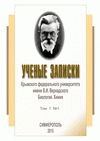The purpose of the study: to study the adaptive mechanisms of the cardiorespiratory system of female students aged 18−20 years during functional training with suspension loops. Research objectives: 1. To determine the indicators of the adaptive mechanisms of the cardiorespiratory system of girls aged 18−20 years engaged in functional training with suspension loops and standard physical education. 2. To identify the dynamics of changes in the adaptive mechanisms of the cardiorespiratory system of girls aged 18−20 years engaged in functional training with suspension loops. Research methods: 40 female students aged 18−20 years of the Federal State Autonomous Educational Institution of Higher Education «SUSU (National Research University)» in Chelyabinsk took part in this study. In our study, to study the cardiorespiratory system, we used measurements of body length and weight, vital capacity (VC), systolic blood pressure (SBP), diastolic blood pressure (DBP), heart rate (HR), chest circumference (CWC), and respiratory rate (RR). Based on the measurements, we calculated the expected vital capacity (EVC), vital index (VI), Bogomozov index, stroke volume (SV), minute volume (MOC), Robinson index, Crempton index, Hildebrandt index, functional change index (FCI), and adaptation potential according to R. M. Baevsky. Ruffier-Dixon, Stange, and Genchi tests were also conducted. Results of the study: The conducted study allowed us to identify various mechanisms of adaptation of the cardiorespiratory system of female students to training on hanging loops. Statistically significant changes in the respiratory system of girls of the main group were revealed according to the parameters of the Stange and Genchi tests, as well as respiratory rate. The parameters of the Genchi test significantly changed by 2.6 seconds (p≤0.05), and the parameters of the Stange test − by 4.6 seconds (p≤0.05). The decrease in respiratory rate was 1.9 times per minute (p≤0.05). The change in these parameters indicates tolerance to hypoxia during exercise and an improvement in the oxygen transport function of the girls’ body as a whole. A reliable decrease in the Robinson index by 10.8 units (p≤0.001) was observed, which indicates the predominance of the parasympathetic regulation circuit of the autonomic nervous system during the adaptation of the girls’ body training on hanging loops. At the second stage of the study, the functional reactivity of the cardiovascular system of the female students of the main group improved according to the Ruffier-Dixon test (p≤0.05). There were also reliable changes in the values of SBP in the main group by 6.5 mmHg (p≤0.05), DBP − by 6.3 mmHg (p≤0.05), HR − by 5.15 bpm (p≤0.05) compared to the control group. The obtained results are fully consistent with the ideas about the economization of the cardiovascular system formed in the process of long-term adaptation to functional training. The level of adaptation potential of the girls of the main group according to the Baevsky index was within the age norm and corresponded to a satisfactory level of adaptation (p≤0.001). According to the Bogomozov index (p≤0.01) and the Adamovich IFI (p≤0.001), the functional capabilities of the cardiovascular system of the girls in the main group were good, and the adaptation mechanisms were stable, the effect of physical activity was compensated by the mobilization of the body’s internal reserves. Conclusion: In connection with the obtained results, it is necessary to continue further research on the influence of training with suspension loops on the functional state of girls in order to find effective combinations of different training modes for the development of long-term adaptation in this fitness area.
cardiorespiratory system, adaptive mechanisms, functional condition, functional training with suspension loops, female students 18−20 years old.
1. Andrejeva J. The effect of TRX suspension trainer and BOSU platform after reconstruction of anterior cruciate ligament of the knee joint / J. Andrejeva, A. Grisanina, G. Sniepienė [et al.] // Pedagogy
2. Vural F. Can different variations of suspension exercises provide adequate loads and muscle activations for upper body training / F. Vural, B. Erman, I. Ranisavljev [et al.] // PLoS One. − 2023. − No. 18 (9).− P. 1−14.
3. Lyun K. Trenirovki s podvesnymi remnyami / K. Lyun, L. Chou; [Per. s angl. pod red. V. M. Bozhenova]. – Minsk : Popurri, 2016. – 144 s.
4. Grabovskaya E. Yu. Fiziologiya adaptacionnyh processov (kurs lekciy) / E. Yu. Grabovskaya. – Simferopol' : FGAOU VO «KFU im. V. I. Vernadskogo», 2020. – 106 s.
5. Komici K. Impact of Body Composition Parameters on Lung Function in Athletes / K. Komici, F. D’Amico, S. Verderosa [et al.] // Nutrients. − 2022. − No. 14 (3844). − P. 1−11.
6. Khatoon Z. Level of cardiovascular fitness and it's relationship with physical activity and body mass index in young adults of Islamabad / Z. Khatoon, M. A. Afridi, Taqdees-e-Maryam [et al.]
7. Tyatenkova N. N. Fizicheskoe razvitie i komponentnyy sostav tela studentok v usloviyah pandemii / N. N. Tyatenkova, A. S. Spivak, A. M. Bragina [i dr.]
8. Suyundikova Zh. T. Funkcional'noe sostoyanie dyhatel'noy sistemy studentok Kostanayskogo gosudarstvennogo pedagogicheskogo instituta / Zh. T. Suyundikova, A. A. Galym // Vestnik KGPI.– 2017.
9. Gross E. R. Funkcional'nye izmeneniya sistem organizma u studentok vysshego uchebnogo zavedeniya pod vliyaniem fizkul'turno-sportivnyh zanyatiy razlichnoy napravlennosti / E. R. Gross, A.
10. Korzhenevskiy A. N. Povyshenie effektivnosti fizicheskoy podgotovki studentov s uchetom dannyh kompleksnogo kontrolya sostoyaniya osnovnyh funkcional'nyh sistem organizma
11. Miroshnikov A. B. Vliyanie vysokointensivnoy aerobnoy raboty na okislitel'nye sposobnosti rabochih myshc i arterial'noe davlenie u sportsmenov silovyh vidov sporta: randomizirovannoe
12. Schankin A. A. Gemodinamika i fizicheskaya nagruzka / A. A. Schankin, G. I. Schankina, N. N. Arbuzov // Science Time. – 2016. – №11 (35). – S. 558−564.
13. Tishutin N. A. Analiz sostoyaniya i reaktivnosti gemodinamicheskih pokazateley u sportsmenov v otvet na dozirovannuyu fizicheskuyu nagruzku / N. A. Tishutin, O. N. Malah, T. Yu. Krest'yaninova
14. Xu H. Study on the accuracy of cardiopulmonary physiological measurements by a wearable physiological monitoring system under different activity conditions / Xu H, Chu W, Liu X [et al.]
15. Klassina S. Ya. Indeks Hil'debrandta kak prognosticheskiy kriteriy otkaza ot intensivnoy fizicheskoy nagruzki / S. Ya. Klassina // Nauka i sport: sovremennye tendencii. – 2019. – T. 7, № 2.
16. Petrova T. N. Sravnitel'naya harakteristika funkcional'nyh vozmozhnostey kardiorspiratornoy sistemy u studentov-sportsmenov / T. N. Petrova, V. K. Talanceva, O. V. Shilenko [i dr.]





